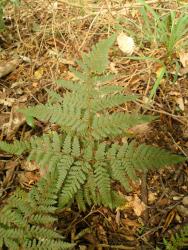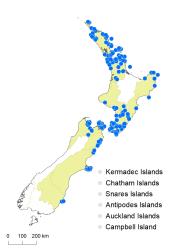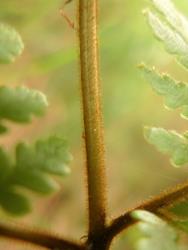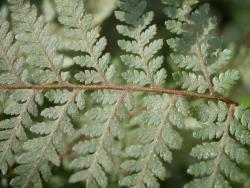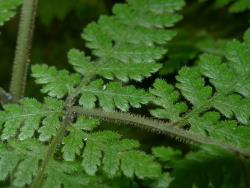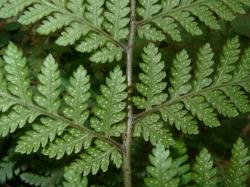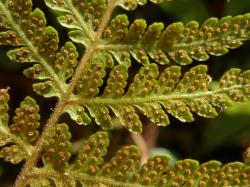- ≡ Aspidium velutinum A.Rich., Essai Fl. Nouv.-Zél., 70 (1832)
- ≡ Lastrea velutina (A.Rich.) Brack., U.S. Expl. Exped., Filic. 16, 198 (1854)
- ≡ Nephrodium velutinum (A.Rich.) Hook.f., Bot. Antarct. Voy. II (Fl. Nov.-Zel.) Part II, 39, t. 80 (1854)
- ≡ Dryopteris velutina (A.Rich.) Kuntze, Revis. Gen. Pl. 2, 814 (1891)
- ≡ Ctenitis velutina (A.Rich.) Copel., Gen. Fil. 124 (1947)
- = Nephrodium pentangulare Colenso, Tasmanian J. Nat. Sci. 2: 169 (1845) – as Nephrodium pentangularum
- ≡ Ctenitis pentangularis (Colenso) Alston, Amer. Fern J. 45: 160 (1955)
- ≡ Lastreopsis microsora subsp. pentangularis (Colenso) Tindale, Contr. New South Wales Natl. Herb. 3: 334 (1965)
- ≡ Parapolystichum microsorum subsp. pentangulare (Colenso) Labiak, Sundue & R.C.Moran, Brittonia 67: 83 (2014)
Rhizomes erect or rarely prostrate, densely scaly. Rhizome scales narrowly ovate to linear, 5–26 mm long, 0.4–2.5 mm wide, golden brown, margins entire. Fronds 240–960 mm long. Stipes 110–530 mm long, red-brown proximally, red- or chestnut-brown distally, densely hairy, bearing scattered scales; scales narrowly ovate, 5–20 mm long, 0.6–1.2 mm wide, pale brown, margins entire or sparsely toothed; hairs 0.2–0.5 mm long, soft, red-brown, acicular. Rachises red- or chestnut-brown, sulcate, narrowly winged only at distal end, abundantly covered in scales and hairs similar to those of the stipes. Laminae 3–4-pinnate, broadly ovate or broader than long, 135–430 mm long, 95–500 mm wide, brownish green on both surfaces, velvety, abundantly covered on all surfaces and margins in soft red-brown acicular hairs, bearing minute yellow clavate glands on both lamina surfaces but more abundant abaxially. Primary pinnae in 10–20 pairs below pinnatifid apex, slightly overlapping; distal pinnae narrowly ovate, proximal pinnae broadly ovate; the longest at or near the base, 75–275 mm long, 33–210 mm wide, apices acuminate, bases stalked; costae winged only in distal half. Acroscopic secondary pinnae decreasing evenly in length along the primary pinnae to the distal end; the basal basiscopic secondary pinna the longest, ovate or narrowly ovate, 23–150 mm long, 10–65 mm wide, apices acuminate, bases stalked, costae winged. Tertiary pinnae ovate or oblong, 6–40 mm long, 2–16 mm wide, apices acute or obtuse, bases stalked or adnate, deeply divided almost to the costa into quaternary segments in largest fronds. Quaternary segments oblong, up to 10 mm long and 6 mm wide, apices obtuse, margins serrate or deeply divided. Sori round, medial; indusia reniform, 0.4–0.6 mm diameter, with a darker central area and yellow glands on the surface and margins.
Lastreopsis velutina is recognised by its erect rhizomes, 3–4-pinnate laminae which have a distinctive velvety feel due to the dense covering of soft red-brown acicular hairs on all surfaces and margins, and small reniform indusia with yellow clavate glands on the margins and surfaces. The very broad laminae and elongated basal basiscopic secondary pinnae on the proximal pair of primary pinnae are also characteristic.
North Island: Northland, Auckland, Gisborne, Taranaki, Southern North Island.
South Island: Western Nelson, Sounds-Nelson, Marlborough, Canterbury, Otago.
Altitudinal range: 0–525 m.
Lastreopsis velutina occurs in coastal and lowland regions of the North Island, extending locally into montane areas. It extends from Te Paki to Wellington but is absent from most of Taranaki, Bay of Plenty, and the central North Island. It grows from near sea level, up to 525 m near Havelock North. In the South Island it occurs from Golden Bay in north-west Nelson, through the Marlborough Sounds and down the east coast as far as Dunedin. It reaches 400 m in the Motueka Gorge, near Nelson.
Lastreopis velutina occurs in drier broadleaved, podocarp, beech, kānuka and coastal forest, and under mānuka scrub. It is found on the forest floor, on well-drained hillsides, rocky slopes, stony ground, clay banks, dry creek banks, alluvial terraces, amongst tree roots, and sometimes on stream banks. It grows on greywacke, limestone and volcanic substrates.
n = 41 (Brownlie 1958 – as Ctenitis velutina).
Brownsey et al. (2019) demonstrated that Colenso’s Nephrodium pentangulare was based on a specimen of Lastreopsis velutina, and it is included here under the synonymy for that species. However, Nephrodium pentangulare was misinterpreted by Cheeseman (1906, 1925), Allan (1961) and Tindale (1965) and included in what is now known as Parapolystichum microsorum. Tindale incorrectly used it as the basis for the new combination Lastreopsis microsora subsp. pentangularis, by which name it has since been known in New Zealand (e.g. Brownsey et al. 1985).



